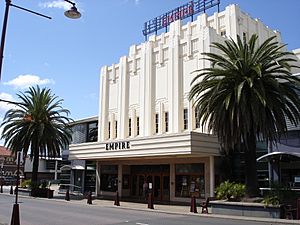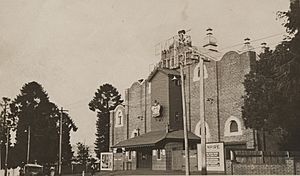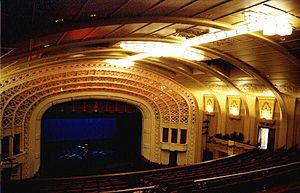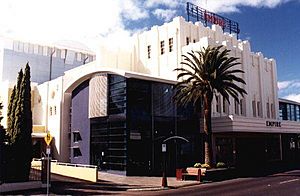Empire Theatre, Toowoomba facts for kids
Quick facts for kids The Empire Theatre |
|
|---|---|

Empire Theatre facade
|
|
| Location | 56 & 56A Neil Street, Toowoomba, Toowoomba Region, Queensland, Australia |
| Design period | 1900–1914 (early 20th century) |
| Built | 1911–1990s |
| Architect | Hall & Phillips |
| Architectural style(s) | Art Deco |
| Owner | Toowoomba Regional Council |
| Official name: Empire Theatre (former), Empire Theatre | |
| Type | state heritage (built) |
| Designated | 31 May 1994 |
| Reference no. | 600978 |
| Significant period | 1911, 1933, 1973–74, c. 1997 (fabric) 1911–1971 (social) |
| Significant components | dress circle, foyer – dress circle, proscenium arch, foyer – entrance, stage/sound shell, auditorium |
| Builders | Kell & Rigby |
| Lua error in Module:Location_map at line 420: attempt to index field 'wikibase' (a nil value). | |
| Empire Theatre, Toowoomba | |
|---|---|
| Other information | |
| Seating capacity | 1,561 |
The Empire Theatre is a famous old theatre in Toowoomba, Queensland, Australia. It is a special building listed on the Queensland Heritage Register since May 31, 1994. This means it's an important part of Queensland's history and culture.
The theatre's design is in the Art Deco style. This style was very popular in the 1920s and 1930s. It reminds people of the "glory days" of Hollywood movies. Outside, you can see palm trees. Inside the main entrance, there are cool metallic gold and bronze colors. One of the most amazing parts of the Empire Theatre is its huge proscenium arch. This is the arch that frames the stage.
The stage itself is very big. It is over 13 meters wide and 12 meters deep. It has lots of space for performers and equipment. There's also an orchestra pit that can move up and down. This allows it to be at the same level as the audience floor or the stage.
Contents
A Look Back at the Empire Theatre's History
The Empire Theatre you see today has two main parts to its story. Most of the building was built in 1933. But it also includes parts of an older theatre from 1911. The Empire Theatre is mostly a large, specially designed Art Deco picture theatre from 1933.
The First Empire Theatre: 1911-1933
The first Empire Theatre opened on June 29, 1911. It was a large brick theatre that could hold 2,200 people. It became very popular. Six businessmen from Toowoomba and a promoter from Brisbane named EJ Carroll built it. They had already been showing films in Toowoomba since 1909. Because movies were so popular, they decided to build a special theatre just for them.
The architect for the 1911 theatre was George Lane. The theatre had a stage for live shows, and early programs included both movies and vaudeville acts. Vaudeville was a type of entertainment with different short acts, like comedy, music, and dance. In 1928, the building was updated. The next year, sound equipment was added. The first "talkie" (a movie with sound) shown in Toowoomba was The Jazz Singer. It played at the Empire Theatre on September 2, 1929.
The Fire and Rebuilding in 1933
The first Empire Theatre was very important to the Toowoomba community. Sadly, it was destroyed by fire on February 22, 1933. Right away, the owners decided to build a new Empire Theatre. It was planned to cost about £30,000. While the new theatre was being built, they showed films at the Town Hall.
The famous architectural firm of TR Hall & LB Phillips designed the new theatre. Construction began in May 1933. The company Kell & Rigby built it. Many parts of the old brick walls from 1911 were still standing after the fire. These were used in the new building. The second Empire Theatre could hold 2,500 people. This made it Queensland's largest theatre outside of Brisbane. It was also one of the biggest theatres in Australia.
A special part of the new theatre was its large gallery, which is like a balcony for seating. It was built using 70 tons of steel. This was a very complex engineering job at the time. The steel parts were made in Brisbane and then brought to Toowoomba by train. They were put together on site. It was seen as a "triumph" in steel construction.
Modern Features and Design
The new theatre mixed the popular Art Deco style with the grand feel of a "picture palace." It had a romantic atmosphere thanks to its special lighting. One great feature was that no columns blocked the audience's view of the stage or screen. The projection room (called the bio box) was the largest in Queensland. The sound was excellent. The theatre also had one of the biggest stages in regional Australia. This meant it could host all kinds of performances, from vaudeville to opera.
Edward Gold, the theatre's chief electrician, created one of the most amazing features. He made the grand proscenium arch light up in constantly changing colors. He did this by reflecting light from behind the arch. This was done using a complex dimmer system. There was also a huge central lamp in the main ceiling. It gave a soft, even light throughout the theatre. In 1933, local newspapers said the Empire Theatre used more diffused lighting than any other theatre in the British Commonwealth.
Most of the builders and materials for the new theatre came from Queensland. This made the local community very proud. The new Empire Theatre, called the "theatre supreme," opened on November 27, 1933. It showed popular movies from Metro-Goldwyn-Mayer.
Changes Over the Years
In 1942, during World War II, people were worried about air raids. A large central ceiling light, nicknamed the 'bomber' light, was removed for safety. It was never put back. The cinema was also closed for parts of the war.
In the 1950s, a CinemaScope screen was added for wider movies. However, fewer people came to the theatre in the 1960s because television became popular. The last film was shown at the Empire on April 1, 1971. The main seating was removed, but most of the Dress Circle seats remained.
In 1973, two Toowoomba businessmen bought the Empire. Later, in 1975, the Queensland Government bought it for Technical College use. It was used as a TAFE facility for many years.
Restoration and Modern Use
The Toowoomba City Council (now Toowoomba Regional Council) bought the theatre. They restored it to its 1933 Art Deco style. It was also updated with modern technical equipment. The theatre reopened in June 1997. In 1998, the Australian Leisure Management Magazine named the Empire Theatre "The Best Theatre in Australia."
In 2005, a Conference Precinct was built. It connected the Empire Theatre to the nearby Church Theatre. This new area included a restaurant and other spaces. In 2009, the Empire Theatre started its Projects Company. This group helps more people in the Toowoomba area get involved in performing arts. In 2010, they launched 'Empire Youth Arts'. This program gives young people chances to learn about and take part in performing arts.
The Empire Theatre celebrated its 100th birthday in 2011. Today, it can seat 1,565 people. It is the largest theatre with a proscenium arch in regional Australia. Many artists who perform there say it's one of the best performing arts venues in Australia.
What the Empire Theatre Looks Like
The Empire Theatre is on Neil Street in Toowoomba. It stands out between the Wesley Uniting Church and the Masonic Lodge. These other buildings are set back, making the theatre look even more impressive.
Exterior Design
The front of the Empire Theatre, facing Neil Street, is in the 1930s Art Deco style. It has smooth plaster over brick. The building looks like a simple cube with a step back at the front. This makes it look taller. The front has equally spaced vertical elements called pilasters. These run across the front and down the sides. The tops of these pilasters look like palm fronds.
Between the pilasters are narrow windows. These windows have decorative parts called mullions. Above these are large rectangular panels with borders. At the very top, above the roofline, is the "Empire" sign. It's a cool, jazzy design made of ironwork with neon lettering.
The original awning used to go down the sides of the entrance area. Now, it only covers the footpath. The sides of the entrance have been filled in by newer buildings. But even with these changes, the building still looks very much like it did originally. The original wooden doors with special glass are still there. So are the display cases on each side.
The outside walls are made of brick. Some of these bricks are from the 1911 theatre that burned down. You can still see the fancy "baroque" style windows from the 1911 theatre on the side walls.
The Fly Tower and Roof
The fly tower is a tall part of the theatre above the stage. It is about 27 meters high. It's made of timber and covered with corrugated galvanised iron. This tower is where scenery and lights are hung and moved up and down during a show.
The main roof is made of corrugated fibrous cement. It is supported by strong steel trusses. These trusses are covered in fibrous plaster. The ceiling inside the auditorium also follows a curve and is lined with a special material called Craftex. This material helps to absorb sound. There are also vents in the ceiling that help with air flow.
Inside the Theatre
The Dress Circle, which is the upper seating area, is supported by a large steel truss. This truss is 21 meters long and means there are no columns to block the view of the stage. This steel structure supports the timber floor and the ceilings below. The use of steel for this part was very advanced for its time.
The proscenium arch is made of a special perforated plaster pattern over a timber frame. It is known for its large size and the amazing lighting effects it used to have.
The theatre still has parts of its original lighting system. This includes old switchboards and large dimmers. Some of the original light fixtures are also still there.
Why the Empire Theatre is Important
The Empire Theatre was added to the Queensland Heritage Register on May 31, 1994. It is important for many reasons:
- Showing History: It shows how stage shows and movies worked together in the early 1900s. It also shows how people's expectations for entertainment grew over time.
- Unique Heritage: It is one of the largest and most complete Art Deco theatres in Australia. It is the best example of an Art Deco picture theatre in Queensland.
- Special Design: It is a great example of Art Deco theatre architecture. Both the outside and inside have beautiful Art Deco details. It also stands out on Neil Street and is a well-known landmark in Toowoomba.
- Technical Achievements: The use of riveted steel girders for the Dress Circle was a big technical achievement. It also still has parts of the old lighting and film projection technology from the 1930s.
- Community Connection: The theatre has been a very important entertainment place for Toowoomba from 1911 to 1971. It played a big role in bringing movies to the area.
- Skilled Work: It shows the great work of Brisbane architects TR Hall & LB Phillips. It also stands as a reminder of the skilled craftsmanship and local technology used in Queensland.




